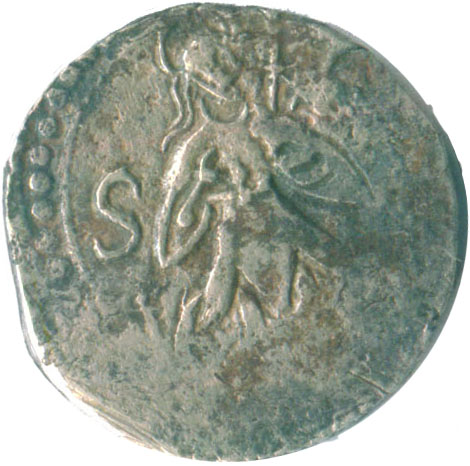| SPECIFICATIONS | |
| Denomination | Two Tanga |
| Alloy | Silver |
| Type | Struck |
| Diameter | 19.5 mm |
| Thickness | 1.7 mm |
| Weight legal | 4.38 gms |
| Weight | 4.00 gms |
| Shape | Round |
| Edge | Smooth |
| DieAxis | 0° |
| Mint | Goa,India |


|

|

| ||||||||||||||||||||||||
| Codrington cf #110 ; Gomes J4: ; F.Vas J4. KM India/Goa#68 | ||||||||||||||||||||||||||
Obverse : Crowned Coat of arms of Portugal divides G A
(Goa) within a circle of dots between two plain line circles.
Reverse : Standing figure facing right with flag divides
S I (São João) and the year 164?
(worn out) within a circle of dots between two plain line circles.
Codrington (VIII-21:III,p.100) lists it among silver coins struck
for Ceylon as the third series Saint type of 1650-1653.
They were minted in Goa with dates 1641, 1642, 1643 and 1649.
The circulation of the São João Tanga was
forbidden in Goa in 1650 when the Cross of Christ
coinage was introduced.
Minting was however continued in Goa with dates 1650, 1651 1652, 1653
and 1655 for circulation only in Ceilão.
Jaffna, the last foothold of the Portuguese fell into the hands of
the Dutch in 1658.
F.Vas lists two series as 1642,43,49 (J4.07 to J4.09) and lighter 1650,51,52,53,55 (J4.17 to J4.21)
Codrington #110 is a one Tanga.
This coin struck at Goa, circulated largely on the island of
Ceylon, with many other Indo-Portuguese coins
Robert Knox in his book History of Ceylon mentions this coin:
"Of money they have but three sorts that passeth for coin in the
King's dominions: the one that was coined by the Portugal; the King's
arms on one side, and the image of a friar on the other, and by the
Chingulays called tangom massa."
In Grogan section on Ceylon the double Tanga is illustrated
(1326) of I6S0 -- 19/20 mm ; 4.27 grams and
(1327) of I6Si -- 20/19 mm ; 4.16 grams.
(1328) of I6Si -- 20/19 mm ; 4.16 grams.
(1329) of I6S2 -- 19/18.5 mm ; 4.20 grams.
The Krause listing of extra year 1656 must be from a similar issue struck for Diu with the initial Å D, which are known for the dates 1654, 1655 and 1656. Mitchiner (#2167) lists the Diu double Tanga with mintmark Å D countermarked in Jaffna with a R.
Text from
* Ceylon Coins and Currency By H. W. Codrington. Colombo 1924
Chapter VIII Portuguese - Plate xxx. Page xxx
* Indo Portuguese Money, by J Ferraro Vaz, . Braga, Portugal 1980 p.163/4
* Moedas Portuguesas 1128-1988, by Alberto Gomes. Lisbon 1987
* Collection Henry Thomas Grogan, J. Schulman, Auction 23-02-1914.
* Non-Islamic and Western Colonies since 600 AD by by Michael Mitchiner.
The F grade coin Scaned at 600 dpi are displayed at 300 dpi. It is from part of Lalith Raddella's collection I purchased in 2016 December.